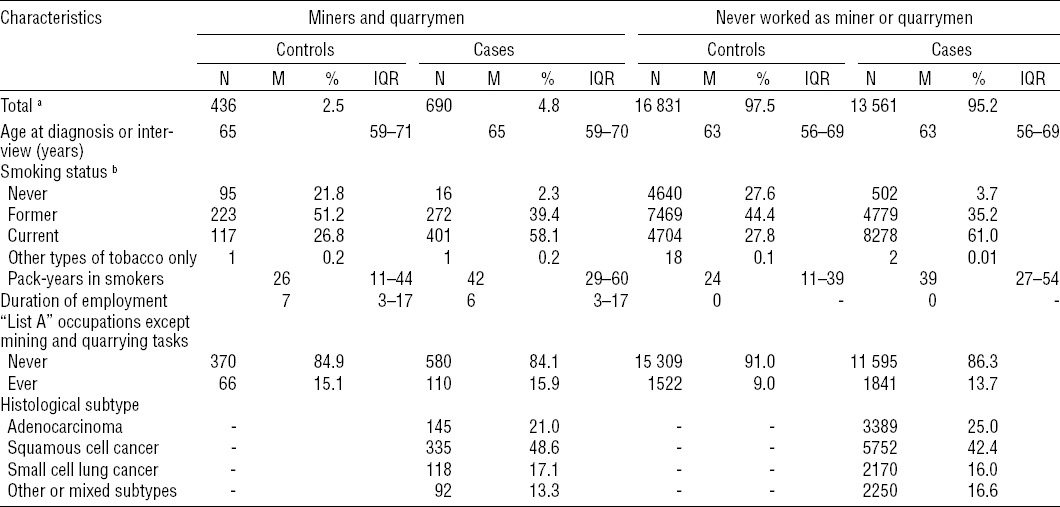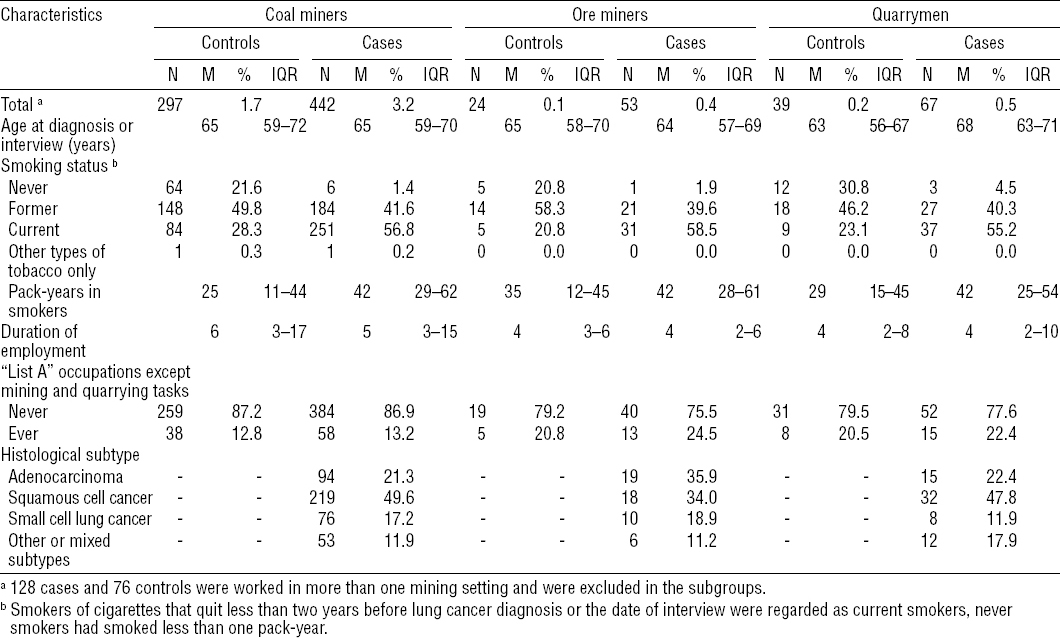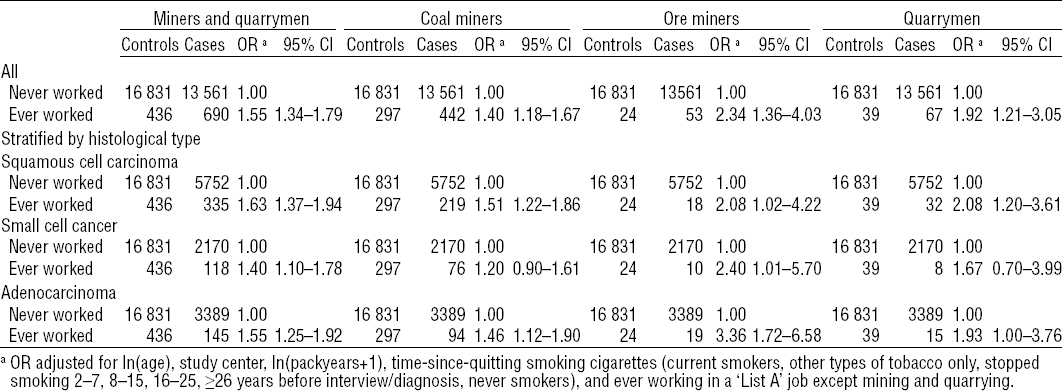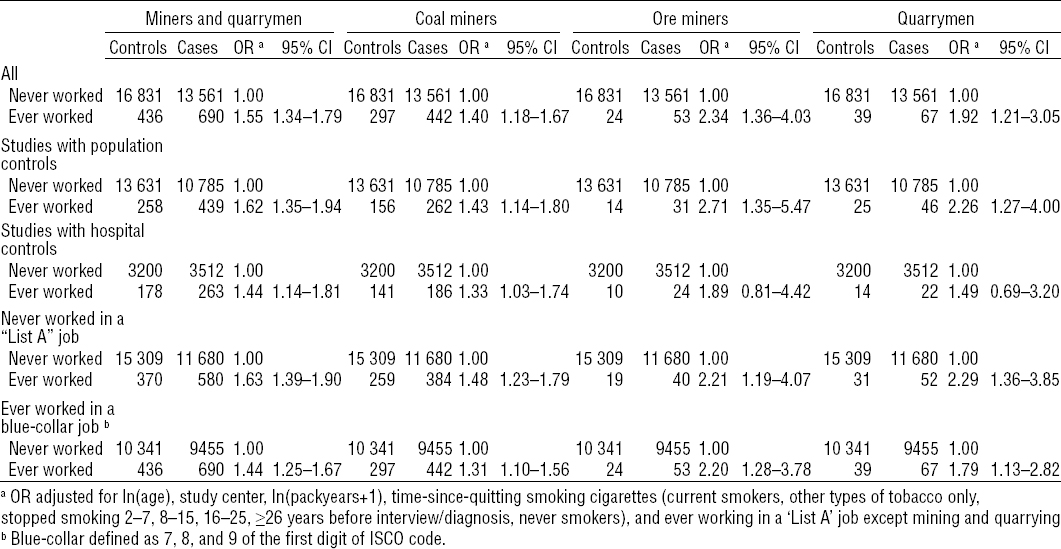Important epochs of mankind are named after the processing of stones and ores, and the industrial revolution was accompanied by the mining of iron ore and coal to a large extent. Although humans have been exposed to the health hazards from mining and stone quarrying for several thousands of years, only at the end of the 19th century have exposure circumstances in those activities been linked to lung cancer (1). A prominent example is known as Schneeberg lung disease named after a small town in the German Ore Mountains, where radon was identified as a major cause of lung cancer (1, 2).
In the second half of the 20th century, several other exposures among underground miners were identified as lung carcinogens, including arsenic, asbestos, chromium (VI), nickel, polycyclic aromatic hydrocarbons (PAH), and silica, and more recently diesel engine exhaust (3). Similarly, quarrymen may be exposed to some of these carcinogens, most typically silica. For some of these occupational risk factors of lung cancer among miners, such as asbestos and radon, more than additive synergistic effects with tobacco smoking have been established (4). The risk of lung cancer entailed in different ore mining and quarrymen settings are determined by the presence of the different lung carcinogens (depending on the minerals mined and other geological characteristics of the mines), exposure levels and their change over time (due to variations in the ores and occupational hygienic controls), potential synergistic effects with tobacco smoking, and accuracy of the study design (particularly exposure assessment and control of tobacco smoking as potential confounder and effect modifier). However, in general, miners rank high among lung cancer risks by occupational groups, as, for instance, reported by Scandinavian countries on a linkage of cancer registry and census data (5).
For coal dust, however, the same IARC working group that first classified crystalline silica as carcinogenic to humans (6) concluded that coal dust was not classifiable as to its carcinogenicity (Group 3), with inadequate evidence on cancer in humans (7). Since then, epidemiological studies have reported mixed results on lung cancer among coal miners (8–18), with extended follow-ups of cohort studies among British and US coal miners recently suggesting a positive association. However, exposure-specific results for coal dust and silica were not coherent between the two studies.
We used the SYNERGY database of pooled case–control studies on lung cancer (19–24) to estimate smoking-adjusted risks for lung cancer among coal miners, ore miners, and quarrymen (http://synergy.iarc.fr). The strengths of the SYNERGY database are detailed information on smoking behavior including the possibility to estimate pack-years of smoking as well as the full occupational history, enabling adjustment for occupational exposure to lung carcinogens from other at-risk jobs. Pooling several case–control studies conducted in different regions has the advantage that miners from a range of different settings were included and the statistical power compared to a single study is much higher.
In this study, we estimate the smoking-adjusted lung cancer risk among coal miners and compare the risk pattern with lung cancer risks among ore miners and quarrymen.
Methods
Study population
This analysis was based on 15 609 lung cancer cases and 18 531 controls from the epidemiological SYNERGY database. Only study subjects without missing values in any of the analysis variables were eligible, leaving 14 251 male cases and 17 267 male controls for data analysis (supplemental table S1, www.sjweh.fi/data_repository.php). The study design has been described in detail elsewhere (22). We included 14 studies that were conducted in 20 study centers in Europe, Canada, and New Zealand between 1985–2010 and restricted the analysis to men, because ever working as a miner was reported by one woman only.
The majority of studies recruited controls from the general population (80% of all controls), and the remaining studies ascertained hospital controls. Controls were either frequency or individually matched to cases by sex and age. Information on occupation and smoking was collected via face-to-face interviews for more than 80% of the subjects. Lung cancer was characterized by major histological subtype (squamous cell cancer, small cell lung cancer, and adenocarcinoma) as previously described (22). All studies were approved by local ethics committees. The IARC Institutional Review Board approved the pooled analysis.
Assessment of working as miner or quarryman
Occupational and other data were pooled according to a common coding manual. The job titles ever held for at least one year were coded according to the International Standard Classification of Occupations, Rev. 1968 (ISCO-68) (25). Industries were coded according to the International Standard Industrial Classification (ISIC) Rev. 2 (26). Miners and quarrymen (ISCO-68 7-1) were defined as shown in supplemental table S2, www.sjweh.fi/data_repository.php. A subject was coded as a coal or ore miner if he had ever worked as miner in coal (ISIC 2100) or ore mining (ISIC 2301/2302), or as quarryman (ISCO 7-11.10) respectively. We did not consider the ISIC code 2901 for quarrymen because this group includes also clay and sand pits. All other participants constituted the reference group. We further assessed ever working in occupations other than mining or quarrying that are known to entail increased lung cancer risks (List “A” jobs) (27). We used an updated version of this list “A” jobs that rates bus and truck drivers and operators of excavating machines also as exposed against occupational lung carcinogens (28).
Statistical analysis
Odds ratios (OR) with accompanying 95% confidence intervals (95% CI) were estimated by unconditional logistic regression for all men working in these settings, and for coal miners, ore miners, and quarrymen separately. We excluded 204 men who worked in more than one setting when estimating OR for working in coal mines, ore mines, or quarries. We assessed duration of working in these settings (0, 1–9, 10–19, ≥20 years) and time since last employment as miner or quarrymen (0, 1–19, 20–39, ≥40 years) in separate models.
The models were adjusted for study, with the INCO study that was conducted in seven countries, being additionally separated by study center. To account for the exponential shape of the age-specific lung cancer incidence, we adjusted for ln(age). Using instead 5-year age categories does not essentially change the results (data not shown). To account for exposure to known lung carcinogens in other occupations, we additionally adjusted for at-risk jobs performed in settings other than mining or quarrying (yes/no). Additionally smoking-adjusted models, including smoking status and pack-years of smoking, were performed. Smoking status was assessed as never, current or former smoking of cigarettes and smoking of other types of tobacco only. Cigarette smokers who had quit <2 years before lung cancer diagnosis or the date of interview were regarded as current smokers. Time since quitting was categorized as 2–<8, 8–≤15, 16–≤25, and ≥26 years. Adjustment for cumulative dose was performed with ln(packyears+1). In other models, we stratified the risk estimation for miners and quarrymen by smoking as never (<1 pack-year), medium (1-19 pack-years), and heavy (≥20 pack-years) smokers. Crude models including only the different mining settings were additionally performed to assess the impact of confounding variables on these risk estimates. In addition, we performed stratified analyses by major histological cell type of lung cancer. We applied sensitivity analyses to assess the possible impact of the type of controls and the possible influence of the individual studies by excluding single studies or restricting the analysis to certain subgroups.
In addition to the pooled analysis, we applied meta-regression models with random effects to estimate OR for the combined and individual studies with Comprehensive Meta-Analysis, version 2.2.027, software (Biostat Inc, Cary, NC, USA). Heterogeneity between studies was assessed by the I2 statistic. All other analyses were performed using SAS, version 9.3 (SAS Institute Inc, Cary, NC).
Results
Description of the study groups
Tables 1a and b depict a description of the study groups. A total of 1126 men (690 cases and 436 controls) had ever worked in mining or quarrying, 3.6% of the total study population. The majority had ever worked as coal miner (442 cases and 297 controls), 53 cases and 24 controls worked as ore miners, and 67 cases and 39 controls as quarrymen. Another 204 men (128 cases, 76 controls) worked in more than one setting during their work history The fraction of never smokers among controls was lower among all miners and quarrymen than in the reference group (21.8% versus 27.6%), and more miners and quarrymen quit smoking (51.2% versus 44.4%). Ore miners among controls smoked more cigarettes but based on smaller numbers (all miners and quarrymen: median 26 pack-years, ore miners: 35 pack-years, other occupations: 24 pack-years). Among ever-smoking lung cancer cases, miners and quarrymen smoked more than the reference group of non-miners (median pack-years 42 and 39, respectively). The median duration of working in mines or quarries was 6 years in cases [interquartile range (IQR) 3–17 years] and 7 years in controls (IQR 3–17 years). Among controls, more miners and quarrymen ever worked in other at-risk occupations than in the reference group (15.1% versus 9.0%). Among cases, miners and quarrymen overall showed a similar distribution of the histological subtypes of lung cancer compared with the reference group of non-miners. Ore miners had a higher proportion of adenocarcinoma of the lung than in other settings based on 19 out of 53 cases.
Lung cancer risks of miners and quarrymen
Table 2 shows the estimates of the crude and smoking- and non-smoking-adjusted lung cancer risk of miners and quarrymen adjusted for ln(age), study center, and employment in other at-risk occupations. Ever working in these occupations was associated with a crude OR of 1.96 (95% CI 1.74–2.22). Adjustment for all factors except smoking reduced the OR to 1.70 (95% CI 1.50–1.93). Smoking adjustment further reduced the OR to 1.55 (95% CI 1.34–1.79).
Table 2
Lung cancer risk among miners and quarrymen (duration of employment and time since last employment). OR=odds ratio; 95% CI=95% confidence interval.]
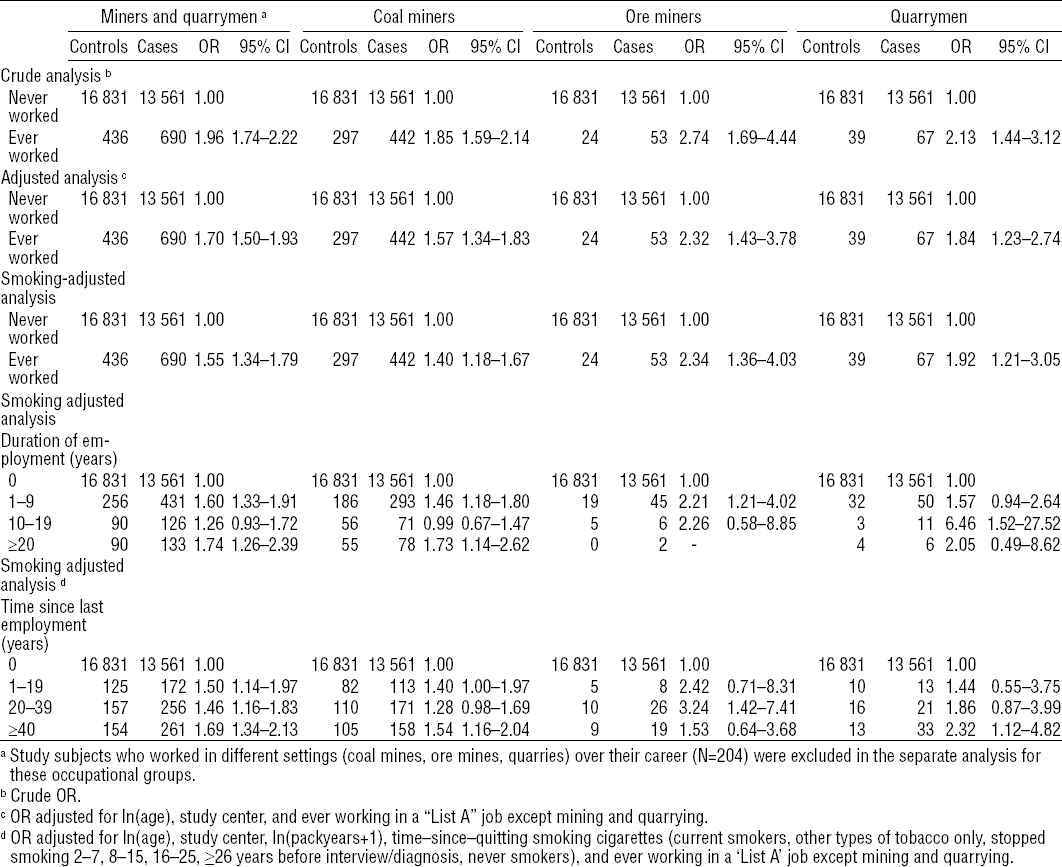
For coal miners, the crude OR of 1.85 (95% CI 1.59–2.14) was reduced to 1.57 (95% CI 1.24–1.83) after adjustment, and further adjustment for smoking behavior reduced the OR to 1.40 (95% CI 1.18–1.67). For ore miners, the unadjusted OR of 2.74 (95% CI 1.69–4.44) was reduced by adjustment, but there are not differences between smoking (OR 2.34; 95% CI 1.36–4.03) or not smoking adjustment (OR 2.32; 95% CI 1.43–3.78). The crude OR for quarrymen was 2.13 (95% CI 1.44–3.12) and non-smoking adjustment reduced it to 1.84 (95% CI 1.23–2.74) while further adjustment for smoking increased it moderately to 1.92 (95% CI 1.21–3.05). The OR was highest among ore miners (2.34, 95% CI 1.36–4.03), followed by quarrymen (1.92, 95% CI 1.21–3.05), and coal miners (1.40, 95% CI 1.18–1.67).
The risk estimates of the potential confounders for the smoking-adjusted model are depicted in supplemental table S3, www.sjweh.fi/data_repository.php. Ever working in an at-risk occupation from “List A” other than mining showed an OR of 1.39 (95% CI 1.28–1.51). The relative lung cancer risk decreased with increasing time since quitting smoking. Smoking was strongly associated with lung cancer, with pack-years dominating the other smoking related covariates.
In comparison with the pooled analyses, the meta-analysis gave similar risk estimates for ever working as miner and quarrymen (supplemental figures S1 and S2, www.sjweh.fi/data_repository.php) with little heterogeneity between studies (I2=10.3 and 4.4, respectively). However, the meta-OR was lower for ore miners (OR 1.65; 95% CI 0.96–2.83) and quarrymen (OR 1.27; 95% CI 0.59–2.71) and showed substantial heterogeneity between the studies, especially for quarrymen (I2=47.0) (supplemented figures S3 and S4, www.sjweh.fi/data_repository.php).
The model with duration of employment showed no clear trend among coal miners (table 2). Working ≥20 years as coal miner was associated with an increased OR for lung cancer (OR 1.73; 95% CI 1.14–2.62). The vast majority of ore miners and quarrymen worked <10 years in these settings. The corresponding risk estimates for long-term work could not be estimated in ore miners due to lacking controls and was 2.05 (95% CI 0.49–8.62) among quarrymen based on four controls and six cases. We further did not observe decreasing risks with increasing time since last employment except for ore miners.
The role of smoking among miners and quarrymen
The relative risk estimates of miners and quarrymen in never, medium, and heavy smokers are shown in table 3. Similar OR were observed among all miners and quarrymen in these groups [<1 pack-year: 1.69 (95% CI 0.96–2.98); 1–19 pack-years: 1.54 (95% CI 1.15–2.07); ≥20 pack-years: 1.53 (95% CI 1.30–1.81)]. We did not observe an increased lung cancer risk in never-smoking coal miners based on six cases (OR 0.99; 95% CI 0.41–2.40). A model with interaction between smoking and working as a coal miner will lead to an coefficient of 0.81 and a P-value of 0.06. Only one case in ore miners and three cases in quarrymen were never smokers.
Lung cancer risk among miners and quarrymen by histological subtype
Ever working as a miner or quarryman was associated with an increased risk for all subtypes of lung cancer. The subtype with the highest OR (1.63, 95% CI 1.37–1.94) was squamous cell carcinoma followed by adenocarcinoma (1.55, 95% CI 1.25–1.92) and small cell cancer of the lung (1.40, 95% CI 1.10–1.78) (table 4). Notably, ore miners showed an OR of 3.36 (95% CI 1.72–6.58) for adenocarcinoma.
Sensitivity analysis
Table 5 presents the risk estimates of sensitivity analyses for ever working as a miner or quarryman. Studies with population controls had somewhat higher risk estimates than studies with hospital controls (1.62, 95% CI 1.35–1.94, and 1.44, 95% CI 1.14–1.81, respectively). Excluding men ever working in other at-risk occupations (“List A” jobs), increased the risk estimates, except for ore miners. Restricting controls to blue-collar workers, decreased the OR (all miners and quarrymen: 1.44, 95% CI 1.25–1.67). The risk estimates excluding single studies one at a time are shown in supplemental table S4, ranging for ever working as miner or quarryman from 1.41 [without Arbeit und Technik (AUT) study] to 1.65 [without Cancer de Pulmon en Asturias (CAPUA) study]. The exclusion of AUT yielded a lower OR for quarrymen (1.25, 95% CI 0.73–2.14).
Discussion
In this pooled analyses of case–control studies, we observed a smoking-adjusted excess lung cancer risk of about 55% among men ever working in mines or quarries; coal miners comprised the largest subgroup of miners and quarrymen. The adjusted risk estimate was highest among ore miners, followed by quarrymen and coal miners. We observed no clear trend with longer duration of employment and time since last employment. However, only few men in these studies worked >10 years as ore miners or quarrymen. The increased risk of coal miners was limited to current and former smokers, but the small number of never smoking cases in these occupations resulted in imprecise risk estimates.
The strengths of this pooled analysis of case–control studies based in the general population are the large number of lung cancer cases and the detailed lifetime information about tobacco smoking habits and employment in other at-risk occupations, which is lacking in most industrial cohort studies of miners and quarrymen. Notably, ore miners and quarrymen had ever worked more often than other occupations in other jobs known to entail an increased lung cancer risk, and there were fewer never smokers among ore miners compared with other occupations. Detailed lifelong occupational information allowed us to disentangle risks in coal and ore mining.
Limitations of our study include missing information on type of ore and the specific job tasks in the mines (eg, tunneling versus coal winning). Further, exposure circumstances vary by mining technology and measures applied to reduce dust exposure, but we had no information on exposure to specific carcinogens and exposure levels over time in ore mining. Also, there was no information on silicosis.
On average subjects in our population-based study worked only seven years as miners or quarrymen, which is a considerably shorter period compared to industry-based cohorts such as those in the US underground coal miner cohort with a mean tenure of 21 years (17, 18). Furthermore, about 75% of all cases had ≥20 years since last exposure and none of them worked as a miner or quarryman at the time of diagnosis. This may have impaired the assessment of trends for duration and time since last employment in these settings. For ore miners and quarrymen, exposure–response results by duration of employment indicate higher risks among those longer employed in such jobs, but results are limited by imprecision. For coal miners, the relative risks are statistically significantly increased among miners employed 1–9 and ≥20 years, and P-values for trend, using continuous duration (P=0.0058) or midpoints of categories (5, 15 and 25 years, respectively; P=0.0010) were statistically significant. Healthy worker survival effect bias is probably present for the group of miners and quarrymen and for coal miners. The decline in lung cancer incidence from duration 1–9 to 10–19 years very likely reflects this. Heavy workloaded jobs are prone to this bias. However, we cannot estimate the effect of healthy worker survival bias with this case–control design.
The results by time since last employment as a miner show a similar pattern, but interpretation is complicated by relatively short median duration of employment in conjunction with relatively long duration since last exposure.
The prevalence of miners and quarrymen among male controls of this study was only 2.5% probably due to the setting of most of the individual case–control studies in major cities. As an example, 10 out of 549 participants of the ROME study reported working in these occupations. Only two studies, AUT in Germany and CAPUA in Spain, covered mining regions (425 and 268 men, respectively), and the vast majority of these miners were coal miners. The OR estimated in the AUT study ranked high and the OR of CAPUA ranked low among all studies in this pooled analysis. However, sensitivity analyses leaving out these and other single studies did not markedly alter the overall results except for a lower risk estimate among quarrymen when excluding AUT. Studies with hospital controls had lower risks than studies with population controls. This can be explained by the fact that other mining-associated diseases can also result in hospitalization (eg, injury, nonmalignant respiratory disease) and may therefore underestimate the OR in comparison to studies with population controls.
It is well established that tobacco-smoking-related lung cancer risks vary by lung cancer histology, with the highest risks for squamous cell carcinoma and small cell cancers (4), and such a pattern has also been reported from the SYNERGY pooled analysis (22). However, evidence on lung cancer risks varying by histology is scarce and incoherent for occupational lung carcinogens, perhaps with the exception of bis(chloromethyl)ether and chloromethyl methyl ether which are believed to be more strongly linked with small cell cancers (29). Ever working as a miner or quarryman was associated with elevated risks for all three major histological subtypes and did not markedly differ by histology. However, a relatively small numbers of cases with longer duration of employment impairs an assessment of subtype-specific lung cancer risks – only 8 and 17 cases reported working at least ten years as ore miner or quarrymen, respectively.
Our results for ore miners and quarrymen are primarily of interest to put our results for coal miners in context. For ever working as a coal miner, the best adjusted effect estimates were lower than for ore miners and quarrymen, but nevertheless showed a modest increase that was robust across all our sensitivity analyses. We observed an adjusted OR of 1.57 before additional adjustment for tobacco smoking and an OR of 1.40 after detailed adjustment for lifelong smoking history, including information on cumulative pack-years smoked, time-since-quitting smoking cigarettes and other types of tobacco habits. The change in point estimate indicates some, but relatively small confounding of lung cancer risks by heavier tobacco smoking in coal miners. There was no evidence of confounding in ore miners and quarrymen. Stratification by smoking status enables the exploration of heterogeneity of lung cancer risks by smoking status. Among coal miners, we observed similarly increased lung cancer risks in medium (of borderline significance) and heavy smokers, but not in never smokers. However, the effect estimate in never smokers was imprecise (OR 0.99, 95% CI 0.41–2.40) due to the small number of never smokers in our data, likely a matter of insufficient statistical power – and the confidence intervals largely overlap. We saw a superadditive effect of smoking and working as a coal miner, but also with low statistical power due to small numbers and healthy worker survival bias in the group of never smoking coal miners.
Elevated lung cancer risks among coal miners were also observed in other case–control studies [eg (9)], although results did not reach the level of statistical significance in all these studies (11). By contrast, a hospital-based case–control study found no excess lung cancer risk among Dutch coal miners (12) in line with a case–control study nested into four industrial cohorts (10). Several large cohort studies did not identify an increased lung cancer risk among coal miners either (15–18). However, a prospective study in Japanese coal miners revealed an elevated smoking-adjusted risk of 2.4 for long-term mining (≥15 years) (14). Evidence of an association between exposure to quartz and lung cancer, but not with coal mine dust, was found in a large cohort of British coal miners (8), while an extended follow-up of a cohort of US coal miners reported an association with coal mine dust, but not with silica exposure (18), with the British cohort having a longer follow-up and a more robust exposure assessment (30).
It is yet not fully clear why studies among coal miners showed inconsistent results. A recent experimental study suggesting a tumor-promotor effect from mountaintop coal-dust (31), but other lung carcinogens like arsenic and radon may also occur in coal mines and contribute to differences in risk. The average annual effective dose in coal mines worldwide was estimated to be 0.36 mSv (32), with variations driven by the geological situation, mining techniques, and ventilation. However, in other mining operations (excluding uranium mining) the average exposure to radon and its decay products worldwide is much higher than in coal mines and was estimated to be 2.4 mSv (32). Depending on the mining area also diesel engines may be operated in coal mines as well as in ore mines. Exposure to crystalline silica is mostly lower than in ore mines or quarries. However, the quartz content in underground coal mines varies by geological characteristics, mining technology and occupational hygiene measures. For example, the mean quartz content was 11% in a German mining region (33), but about 30% in Japan (34). Also, the quartz content is higher during development heading, albeit usually still at lower levels than in ore mines or quarries, and there are different exposure circumstances between underground and surface mining. A potential masking effect of coal dust that deactivates the aggressive surface of the quartz particles has also been proposed (35, 36). Different risks may also be due to interaction of quartz with other minerals – such as iron – or by different quartz varieties (36, 37). The German Health Protection Mining Ordinance (GeSBergV) defines multipliers (between 0.3 and 1) for the specific potency of quartz for different coal mining areas in Germany (38). Differences of lung cancer risks of coal miners between studies may be at least partially explained by some of the factors summarized above.
In conclusion, this pooled analysis of population-based studies demonstrated an excess lung cancer risk among coal and ore miners and quarrymen that remained increased after detailed adjustment for smoking and working in other at-risk occupations; the risk among coal miners was lower than for ore miners or quarrymen but nevertheless provided some evidence for increasing risks with increasing duration of employment. Further studies based on exposure assessment for coal dust and silica are warranted.
Conflicts of Interests
Dirk Taeger, Beate Pesch, Benjamin Kendzia, Thomas Behrens, and Thomas Brüning, as staff of the Institute for Prevention and Occupational Medicine (IPA), are employed at the “Berufsgenossenschaft Rohstoffe und chemische Industrie” (BG RCI), a public body, which is a member of the study’s main sponsor, the German Social Accident Insurance. IPA is an independent research institute of the Ruhr-Universität Bochum. The authors are independent from the German Social Accident Insurance in study design, access to the collected data, responsibility for data analysis and interpretation, and the right to publish. The views expressed in this paper are those of the authors and not necessarily those of the sponsor. The other authors report no conflicts of interest.


